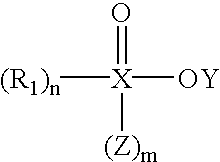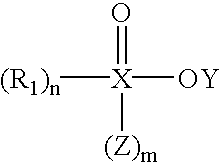Ultrasonic assisted deposition of anti-stick films on metal oxides
a technology of anti-stick film and metal oxide, which is applied in the direction of electric/magnetic/electromagnetic heating, mechanical vibration separation, instruments, etc., can solve the problems of difficult removal of plastic materials from metal or glass molds without damaging the surface finish or leaving undesirable residues on either the molding surface or the finished product, and aluminum is inherently very soft and easily scratched
- Summary
- Abstract
- Description
- Claims
- Application Information
AI Technical Summary
Benefits of technology
Problems solved by technology
Method used
Image
Examples
first embodiment
[0073] Referring now to FIGS. 12-13, a mold constructed according to the present invention is illustrated. A mold 700 is constructed from a first 702 and second 706 plate member separated by a gasket 704. In the actual embodiment, the cell cast mold can include two plates of aluminum 702, 706, each member being coated at least on one facing surface with a thin metal oxide 708, 710 or anodized in any suitable fashion that is known in the art. The plate members 702 and 706 suitably undergo sonication as described above, thus providing a non-stick film on each plate members. The plate members 702, 706 are separated by a silicone rubber or other rubber-like elastomeric gasket material 704. The gasket 704 is placed in between the facing surfaces of the first mold member 702 and the second mold member 706 in a manner so as to leave an opening 720 in the mold 700. The opening 720 is used to pour the resin composition in the mold 700. The gasket 704 forms a seal on three sides between the p...
example 1
[0082] Aluminum Alloys 6061 and 7075 were anodized so as to produce a 0.002" thick alumina feature over the aluminum substrate. Alloy 6061 is comprised of 0.8-1.2% Mg, 0.4-0.8% Si, 0.15-0.40% Cu, 0.25% Cr 3 and alloy 7075 is comprised of 5.5% Zn, 2.5% Mg, 1.5% Cu, 0.3% Cr, 0.2% Mn A solution was prepared having 0.4% by weight Zonyl UR (an anionic phosphate fluorosurfactant produced by DuPont) dissolved in a 60 / 40 DI water / isopropanol. The solution was added to a benchtop Branson ultrasonic bath (Model No. 2510).
[0083] The fluorinated phosphate ester was deposited on the anodized aluminum with the aid of sonication using the Branson ultrasonic bath at 45.degree. C. solution temperature and for a relatively long treatment time of up to 30 minutes. Following this treatment, water drops demonstrated a 110.degree. contact angle, which indicates that a low surface energy coating was deposited.
[0084] As a control, untreated plates were treated only in room temperature water. The casting ma...
example 2
[0090] Tooling Aluminum plates were milled to form casting cell molds. These plates were then anodized so as to produce a 0.001" thick porous alumina structure over the aluminum substrate.
[0091] The phosphonic acid solution as described in Example 1 was poured into a shallow plastic container.
[0092] The mold plate was placed in the phosphonic acid solution and treated with a Misonix Sonicator Ultrasonic Processor XL-2020, 20 kHz equipment used in the USAD process as illustrated in FIG. 9. The anodized aluminum plate was translated beneath the stationary horn equipped with a 1 / 2 inch tip at a rate of approximately 0.25 inches / second. The water-alcohol bath was moved in a linear fashion along one edge of the anodized aluminum plate. Upon reaching the edge of the aluminum, the translation stage moved the bath 1 / 2 inch and the horn then passed over an untreated path adjacent to the first path. This stepping pattern was repeated until the desired workpiece surface was completely exposed ...
PUM
| Property | Measurement | Unit |
|---|---|---|
| frequency | aaaaa | aaaaa |
| temperature | aaaaa | aaaaa |
| thickness | aaaaa | aaaaa |
Abstract
Description
Claims
Application Information
 Login to View More
Login to View More - R&D
- Intellectual Property
- Life Sciences
- Materials
- Tech Scout
- Unparalleled Data Quality
- Higher Quality Content
- 60% Fewer Hallucinations
Browse by: Latest US Patents, China's latest patents, Technical Efficacy Thesaurus, Application Domain, Technology Topic, Popular Technical Reports.
© 2025 PatSnap. All rights reserved.Legal|Privacy policy|Modern Slavery Act Transparency Statement|Sitemap|About US| Contact US: help@patsnap.com



